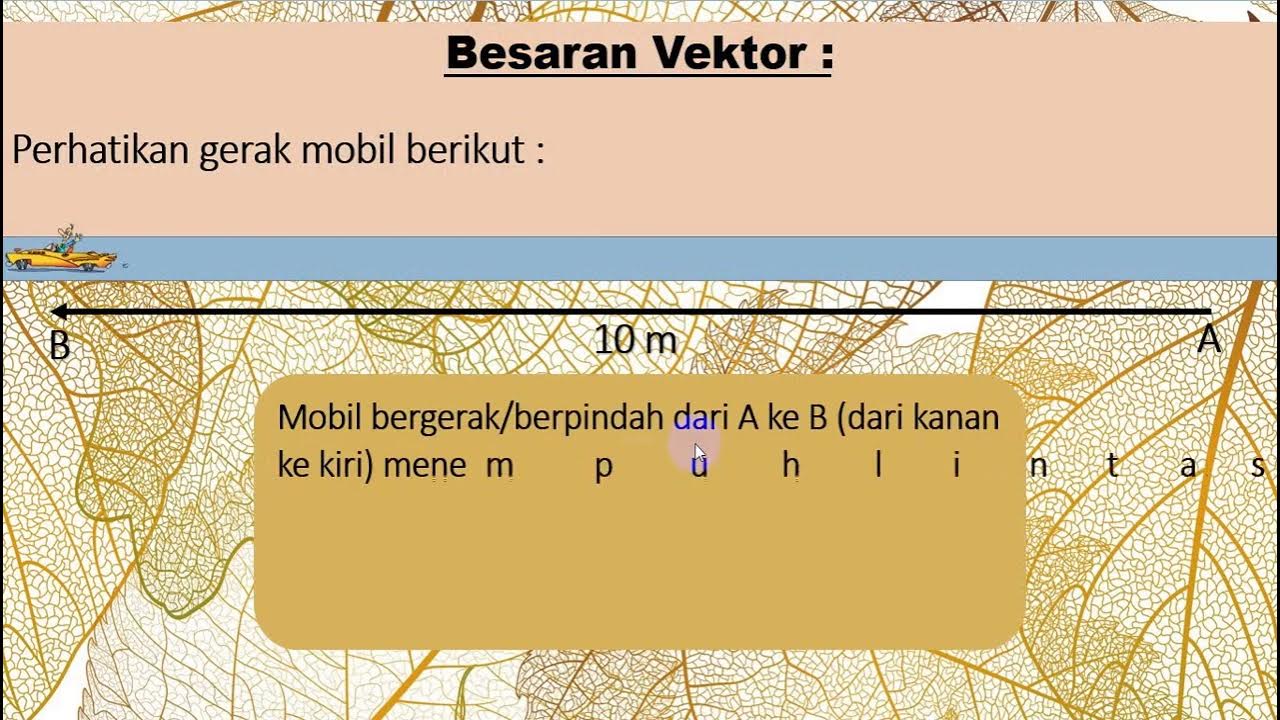Definições de Grandezas Físicas: Escalares e Vetoriais - Principais diferenças
Summary
TLDRIn this lesson, we explore the fundamental concepts of scalar and vector quantities. Scalars are quantities that are defined by only a number and a unit, like temperature or time. Vectors, on the other hand, require three parameters: magnitude, direction, and sense. The video uses examples such as displacement, velocity, and force to illustrate vector quantities, emphasizing how direction and sense are crucial to understanding them. The lesson highlights the importance of these distinctions, helping viewers grasp the difference between scalar and vector quantities for further study in physics.
Takeaways
- 😀 Scalar quantities are fully defined by a number and a unit of measurement, such as temperature, time, and mass.
- 😀 Example of scalar quantities: Temperature (e.g., 5°C), Time (e.g., 4 p.m.), and Volume (e.g., 3 liters of water).
- 😀 Scalar quantities do not require direction or sense to be fully understood.
- 😀 Vector quantities, such as displacement, velocity, acceleration, and force, require magnitude, direction, and sense.
- 😀 To understand displacement, you need not only the distance but also the direction and sense (e.g., 500 meters to the right).
- 😀 A scalar quantity gives complete information with just a number and a unit, such as when you are told to drink 3 liters of water a day.
- 😀 In contrast, vector quantities like displacement or force need more information to specify their direction and orientation.
- 😀 Displacement is a vector because it requires both magnitude and direction (e.g., 500 meters north).
- 😀 The rule for distinguishing scalar and vector quantities is to check if the quantity requires direction and sense in addition to magnitude.
- 😀 In daily life, scalar quantities are sufficient for clear understanding (e.g., a temperature reading), while vector quantities are needed for movement and force applications (e.g., direction to turn while driving).
Q & A
What is the main difference between scalar and vector quantities?
-Scalar quantities are defined by just a magnitude (number) and a unit, while vector quantities require three parameters: magnitude, direction, and sense.
Can you give an example of a scalar quantity and explain why it is scalar?
-An example of a scalar quantity is temperature. For instance, if the temperature is 5°C, it is scalar because you only need the number (5) and the unit (°C) to understand the information.
What makes displacement a vector quantity?
-Displacement is a vector quantity because, in addition to the magnitude (distance), it requires a direction and sense. For example, knowing that a house is 500 meters away from an intersection is insufficient without knowing the direction to travel.
What are the three parameters needed to define a vector quantity?
-The three parameters required to define a vector quantity are magnitude, direction, and sense.
Why is time considered a scalar quantity?
-Time is a scalar quantity because it is defined by a number (e.g., 4 p.m.) and a unit (hours), and no direction or sense is needed to understand it.
How does direction and sense affect vector quantities like velocity?
-For vector quantities like velocity, both the magnitude (speed) and the direction (e.g., north, south) are required. The sense indicates whether the direction is in one way or the opposite (e.g., north or south).
Why can't you determine the exact location of a friend's house with just the distance of 500 meters?
-With just the distance of 500 meters, you cannot determine the exact location because you need additional information about direction and sense (e.g., north or east) to pinpoint the location accurately.
How does knowing direction and sense help in real-world applications like navigation?
-In real-world applications like navigation, knowing the direction and sense helps you determine the exact route or position. For instance, a GPS system that says 'turn left' or 'turn right' provides the necessary direction to guide you.
Why do vector quantities require more information than scalar quantities?
-Vector quantities require more information because they describe not only how much (magnitude) but also in which direction and sense something occurs, which is necessary for accurate description and application in physical situations.
What would happen if you applied force in the wrong direction, for example when tightening or loosening a screw?
-If you apply force in the wrong direction when tightening or loosening a screw, the force will be ineffective or could lead to the opposite result, such as tightening instead of loosening the screw.
Outlines

This section is available to paid users only. Please upgrade to access this part.
Upgrade NowMindmap

This section is available to paid users only. Please upgrade to access this part.
Upgrade NowKeywords

This section is available to paid users only. Please upgrade to access this part.
Upgrade NowHighlights

This section is available to paid users only. Please upgrade to access this part.
Upgrade NowTranscripts

This section is available to paid users only. Please upgrade to access this part.
Upgrade NowBrowse More Related Video

Besaran vektor dan besaran skalar (Fisika SMA/MA Sagufindo kls X smt 1 : Vektor)

Cinemática 04: Grandezas Vetoriais e Escalares

Grandezas vetoriais x escalares - VETORES - Aula 1 - Prof. Marcelo Boaro

Introdução ao Estudo da Física e Grandezas | Física - aula #1 | prof. Yuri Alves | Extensivo NPAC

GCSE Physics Revision "Scalar and Vector Quantities"

Vektor.
5.0 / 5 (0 votes)